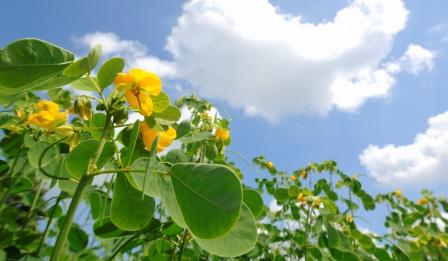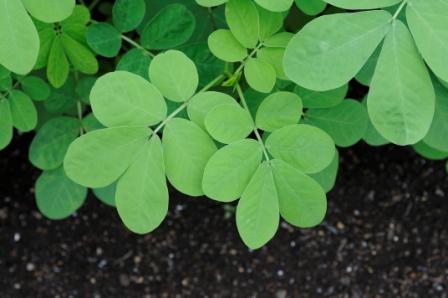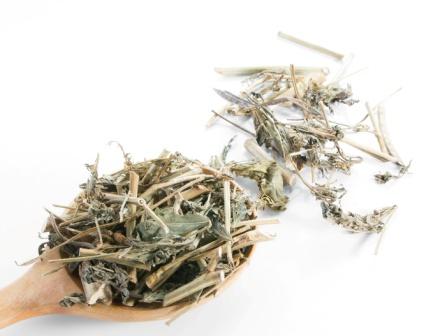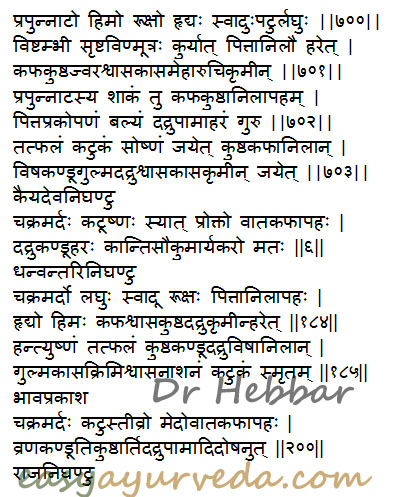Cassia tora – Chakramarda Uses, Dose, Research
Chakramard – Cassia tora is probably the underdog among medicinal herbs. It has anti-cancer potential, externally used for snake bite poisoning, it reduces cholesterol and more.
Botanical name- Cassia tora Linn, Cassia boreensis Miq., Cassia borneensis Miq., Cassia gallinaria Collad., Cassia numilis Collad.
Family- Caesalpiniaceae (Simbi kula); Putikaranja upakula
Table of Contents
Classification
Kingdom -Plantae
Division -Magnoliophyta
Class – Magnoliopsida
Subclass – Rosidae
Order – Fabales
Family – Fabaceae
Subfamily – Caesalpinioideae
Tribe – Cassieae
Sub-tribe – Cassiinae
Genus: Cassia
Species: Cassia tora

Vernacular names
Names in different languages:
English name – Ring-worm plant, sickle senna, sickle pod, tora, coffee pod, tovara, chakvad and fetid cassia
Hindi name -Chakavad, Pavand, Chakwad, Chakvad
Telugu name – Tagirise, Tantepu chettu
Tamil name – Taghrai
Bengali name – Chavuka
Marathi name – Takla
Gujarati name – Kuvadiyo
Telugu name – Tagirise
Malayalam Name – takara

Sanskrit synonyms
Kharjughna, Dadrughna – cures Dadru – ringworm
Edagaja, Andagaja, Gajakhya, Andahasti, Chakragaja,
Kshodaka, Mardaka, Pamato, Meghakusuma, Prapunnata, Punnata, Prapunnada, Taravata, Vyavartaka, Padmata,
Avartaka, Chakrika, Chakrahva, Chakramarda – Chakra refers to a wheel, or ringworm. It is useful to cure ringworm infection.
Meshakshi kusuma, Mesha Lochana – flowers and leaves resemble eyes of Mesha – sheep
Drudabeeja – Seeds are hard
Pamaghati – Useful in skin disorders
Classical categorization
Charaka- Shaka varga – leafy vegetable group of herbs
Kaiyadeva Nighantu – Oshadhi Varga
Dhanvantari Nighantu – Karaveeradi Varga
Bhavaprakasha – Hareetakyadi Varga
Raja Nighantu – Shatahvadi Varga
Chemical constituents
Cassia tora chemical Constituents- Fistucacidin, emodin, Rubro fusarin, Torosachrysone, Isotoralactone, Questin, Obtusin, Obtusifolin, Alaternins, Cassiaside etc. (JLN Shastry)
Chrysophanol is its marker compound.
Seeds: cinnamaldehyde, gum, tannins, mannitol, coumarins, aldehydes, eugenol and pinene, sugars, resins.
Root: Beta sitosterol, Beta-D glucoside, palmitic acid, stearic acid, uridine, quercitin, iso-quercetin.
Variety, habitat
Variety: Cassia obtusifolia is considered as a variant of this plant.
Habitat: Available throughout India, in hotter regions.

Properties, part used, dosage
Cassia tora medicinal properties: (Rasapanchaka)
Guna (qualities) – Laghu – light to digest, Rooksha – Dryness
Rasa (taste) – Katu –pungent
Vipaka- Katu – Undergoes pungent taste conversion after digestion
Veerya – Ushna – Hot potency
Effect on Tridosha – Balances Vata Dosha
Pharmacological action – Laxative, Anti microbial, Hepato – protective, Anti oxidant, Anthelmintic
As per Bhojana Kutuhalam twelfth chapter, chakramarda is pungent in taste, causes severe intoxication and alleviates vitiated vata and kapha dosha. It treats wounds, itching, skin diseases, colicky pain etc. Chakramarda that is imported from a foreign island is bigger in size and treats dadru.
Part used– Seeds. shoots, leaves, roots. Its plants, seeds are edible. Leaves are used as vegetables. Its roasted seeds are used as a substitute for coffee.
Dosage- Seeds powder 1-3 g; leaf juice 5-10 ml
Sanskrit verse

Uses, indications
Chakramarda – Cassia tora uses:
Ushna – hot
Rooksha – dry
Hrudya – acts as cardiac tonic, congenial for heart
Svadu – sweet
Katu – pungent
Laghu – light to digest
Vishtambhi – constipative
Srushta Vit Mutra – increases volume of urine and feces
Pittanilahara – balances Pitta and Vata Dosha.
Kantikara – improves skin glow and complexion
Soukumaryakara – imparts softness and makes it look young
Hrudya – acts as cardiac tonic, congenial for heart
Medohara – reduces fat and cholesterol levels
Indicated in:
Kushta – skin diseases
Jwara – fever
Shwasa – asthma and chronic respiratory disorders
Kasa – cough, cold
Meha – diabetes, urinary tract disorders
Aruchi – anorexia
Krumi – worm infestation
Vrana – Ulcers, wounds
Pama – Keloids, Papules
Shaka – shoot and leaves
Guru – heavy to digest
Kaphahara – balances Kapha, useful in productive cough, asthma, bronchitis, chest congestion
Anilahara – useful in treating disorders of Vata Dosha imbalance such as neuralgia, paralysis, constipation, bloating, etc
Pitta prakopana – increases Pitta Dosha.
Balya – improves strength and immunity
Indicated in :
Kushta – skin diseases
Dadru – ringworm / tinea infection
Pama – Keloids, Papules
Cassia tora fruits (pods)
Katu – pungent
Ushna – hot
Balances Kapha and Vata Dosha
Indicated in:
Kushta – skin diseases
Visha – Toxic conditions, poisoning
Kandu – itching, pruritis
Gulma – Tumors of the abdomen,
Dadru – ring worm / tinea infection, urticaria, itching, allergic skin rashes,
Kasa – cough, cold
Shwasa – asthma and chronic respiratory disorders
Krumi – worm infestation
Visha – toxic conditions, poisoning. It is used for the treatment of snake bite poisoning.
Gulma – Tumors of the abdomen
Its Kashaya – water decoction is used for the treatment of fever.
The plant is known to possess hypolipidemic activity – reduces LDL cholesterol and increases HDL (good cholesterol).
Anti-tumor activity: Emmodin – an anthraquinone, present in roots and bark is being studied along with chemotherapy for cancer treatment.
It also possesses anti-genotoxic (protects DNA damage), anti inflammatory and anti hepatotoxic (protects liver), anthelmintic, anti oxidant, anti bacterial, anti nociceptive and hypotensive activities.
External application
Seed paste is applied externally in eczema,leprosy, tinea, allergic dermatitis, psoriasis, inflamed pile mass, and snake bites, insect bites etc.
Fresh leaves are pounded with alcohol or vinegar and are applied externally to treat eczema and psoriasis.
Ayurvedic medicines
Ayurvedic medicines containing Cassia tora as ingredient:
Cutisora oil – used for the treatment of psoriasis.
Edagajadi lepa
Dadrughni vati
Interaction with medicines, supplements
Can this be used while taking Homeopathic medicine?
Yes. This product does not react with homeopathic medicine.
Can
this medicine be continued while taking supplements like multivitamin tablets,
Omega 3 fatty acids etc?
Yes. Generally, this product goes well with most
of the dietary supplements. However, if you are taking more than one product
per day, please consult your doctor for an opinion.
With western
medicines
Seek your
doctor’s advice if you are taking this product along with other western
(allopathic / modern) medicines. Some Ayurvedic herbs can interact with modern
medicine.
If both Ayurvedic and allopathic medicines are advised together, then it is
best to take Allopathic medicine first, wait for 30 minutes and then take the
Ayurvedic medicine.
Research
Research studies on Cassia tora:
Anti-bacterial activity: Ethanolic and aqueous extracts from the leaves of Cassia tora were studied for antibacterial activity, in a concentration of 0.15 mg, 0.31 mg. Ciprofloxacin was used as a standard reference. The study involved determination of inhibition zone in mm. Both the extracts exhibited significant antibacterial activity.
Sthanika Karma (Systemic Action)
External – Seed paste is indicated in skin disorders and has Anti poisonous and scraping action. Beneficial in Hemorrhoids. Its root kept in curd or sour gruel and mixed with lemon juice can be applied on dadru kushta.
Nervous System – Strengthen the nervous. Indicated in Hemiplegia, Facial palsy, etc.
Digestive system – Anti helminthic, stimulates the liver, helps the movement of doshas in proper direction. Indicated in constipation, Phantom tumor, Hemorrhoids, and in Helminthiasis.
Circulatory System – Leaf is indicated in Heart related diseases, Act as a blood purifier.
Respiratory system – Indicated in cough, and in breathing difficulty. Expel out vitiated kapha dosha
Satmikarana – It can be used as a preventive medicine for contagious diseases, obesity, and in various poisons.
Skin – Leaves and seed powder is indicated in various r skin disorders
Tapakrama – Leaf juice is beneficial in Fever (Vata kapha jvara)











3 comments
Dr. Balraj Singh
how cassia tora seed treat tinea,psoriasis
Dr J V Hebbar MD(Ayu)Author
1. Its paste or juice extract is applied externally.
2. Sesame oil – 20 parts is added to cassia tora and cooked, filtered. This oil is applied externally to treat tinea, psoriasis.
Aalok
It is also a potential cure for Parkinson’s.